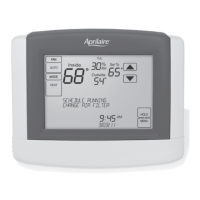In a TDMA system, all thermostats and the Host controller must be synchronized to ensure proper timing for control of the Host controller’s
receive lines. This is accomplished by synchronizing on the receipt of the Carriage Return <CR> character. Upon receipt of the <CR> character,
each connected node resets its communication timer, slot counter and frame counter, regardless of message syntax or content. The node may not
begin sending unsolicited messages until a carriage return is received and synchronization has occurred. In addition, the Host controller transmits
a <CR> every 12 hours to ensure accurate synchronization. Also, upon completion the last slot (maximum address), the Communication Frame
resets, setting the slot counter to 1, and the cycle repeats. The following figure depicts slot timing with and without receipt of a carriage return.
Slot 1 Slot 2 Slot 3 Slot 4 Slot 5
•••
Slot 63 Slot 64 Slot 1 Slot 2 Slot 3 Slot 4 Slot 1 Slot 2 Slot 3 Slot 4
•••
t = 0 Time
Slot counter is reset
after max address
slot is completed
Slot counter is reset
after Carriage Return
is received
NOTE: The number of slots shown is based on the max number of thermostats and thus a max address of 64. Applications with a lower max
node address restarts the slot counter after the max address slot has completed.
HOST MESSAGE TYPES
Host controller message transmissions are not governed by slot timing since the Host controller is the only device on its respective transmit line.
The Host controller does however need to meet specific timing to prevent missed commands and collisions. Command timing is determined by
the type of response as follows:
When a response to an Explicit Address Command is desired, slot width + sub-slot width time must elapse after issuing an Explicit Address
Command before issuing a second command to the same node.
When a response to a Global Address Command is desired, slot width * max node address time must elapse after issuing a Global Address
Command before issuing a second command when a response is desired.
RESPONSE EXPECTED
When no response to either an Explicit Address Command or Global Address Command is desired, slot width + sub-slot width time must
elapse after issuing either command before issuing a second command to the same node.
NO RESPONSE EXPECTED
NODE MESSAGE TYPES
There are three node message types. Each message type has a specific time for the node to transmit a message. The three message types are
as follows:
1. Explicit Address Command Response
2. Global Address Command Response
3. Unsolicited Message
As shown in the figure below, during the n
th
slot the n
th
node responds to a global or explicit address command during the first sub-slot and/or
sends an Unsolicited Message during the second sub-slot.
Slot n
Address n Global or Explicit
Response Sub-slot
Address n Unsolicited
Message Sub-slot
Expansion Sub-slot 1 Expansion Sub-slot 2
3

